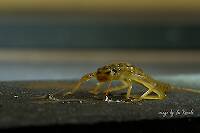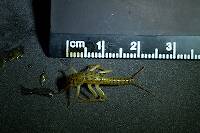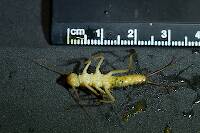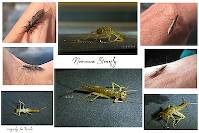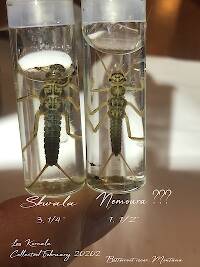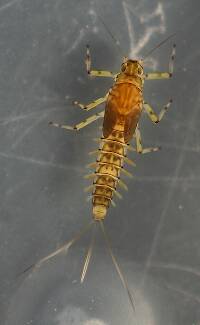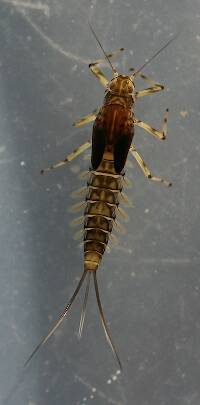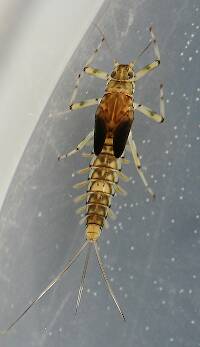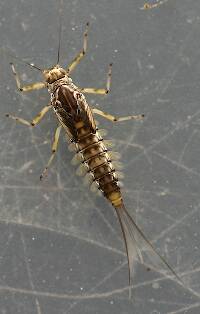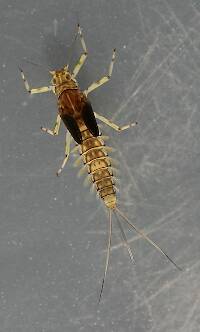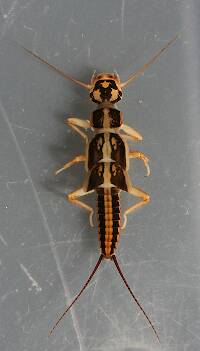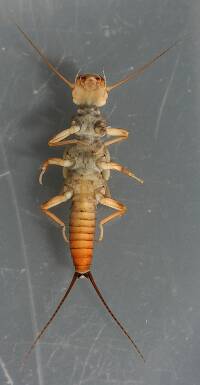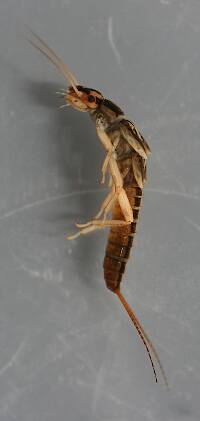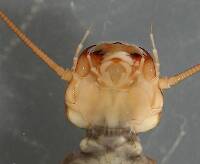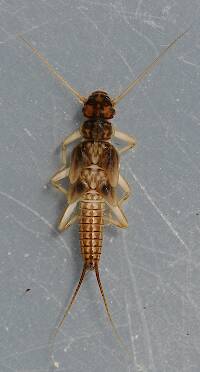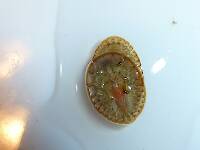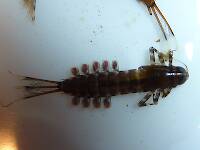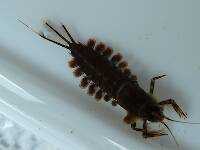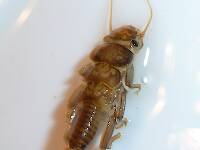
Blue-winged Olives
Baetis
Tiny Baetis mayflies are perhaps the most commonly encountered and imitated by anglers on all American trout streams due to their great abundance, widespread distribution, and trout-friendly emergence habits.
Featured on the forum

I caught this tiny larva without a case, but it seems to key pretty clearly to to Glossosomatidae. From there, the lack of sclerites on the mesonotum points to either Glossosoma or Anagapetus. Although it's difficult to see in a 2D image from the microscope, it's pretty clear in the live 3D view that the pronotum is only excised about 1/3 of its length to accommodate the forecoxa, not 2/3, which points to Glossosoma at Couplet 5 of the Key to Genera of Glossosomatidae Larvae.

Troutnut is a project started in 2003 by salmonid ecologist Jason "Troutnut" Neuswanger to help anglers and
fly tyers unabashedly embrace the entomological side of the sport. Learn more about Troutnut or
support the project for an enhanced experience here.
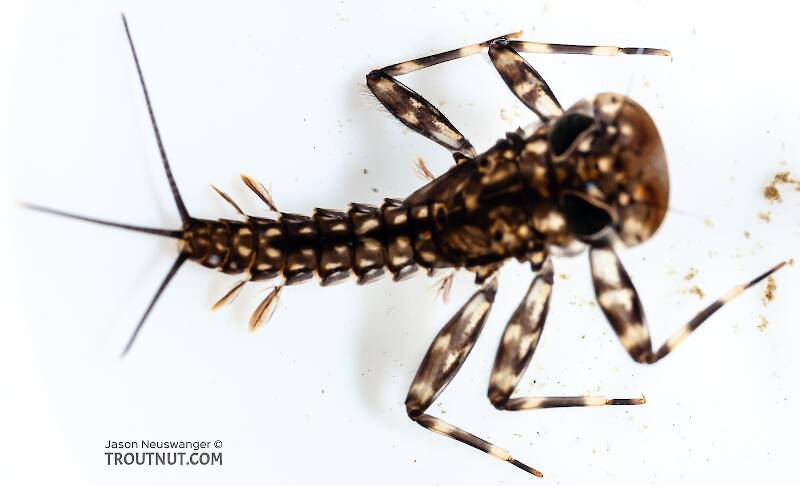
Like most Alaskan mayflies, this one is tricky to identify to the species level. See the discussion section for an informative chat about this one's ID. The current leaning is to call it a fairly immature Heptagenia pulla nymph, but a case has been made for Heptagenia elegantula as well.
Entoman on Jul 15, 2011July 15th, 2011, 2:39 pm EDT
We have truly gone from the ridiculous to the sublime.:)
"It's not that I find fishing so important, it's just that I find all other endeavors of Man equally unimportant... And not nearly as much fun!" Robert Traver, Anatomy of a Fisherman
Jmw975 on Jul 21, 2011July 21st, 2011, 7:20 pm EDT
Okay, this is my first post on troutnut, but I'm willing to step into the fray :)
First of all, on the identification:
To me this looks closest to H. pulla. In the west, H. elegantula tends to have the pale areas on the abdominal terga joined to almost form a pair of pale lines and smaller lateral spots.
Here is a 'typical' H. elegantula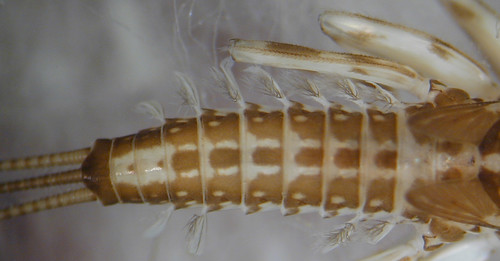
Here is an H. pulla from Saskatchewan
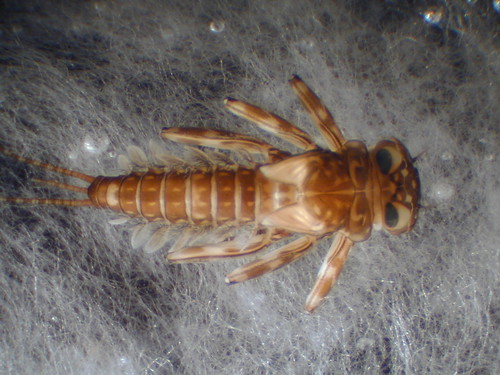
Both of the above specimens are preserved in alcohol, so in life they might be slightly different in hue, but should have the same colour pattern.
Secondly, on DNA taxonomy:
I was going to write a big bit defending the use of DNA in taxonomy, but I think it comes down to this: DNA is simply another tool for helping to tell species apart and associating the nymphs and adults. It isn't going to replace actually looking at a specimen. Species concepts are hypotheses and are bound to change when new tools are used. In the past we scientists have been limited to morphology, and to a lesser extent ecology, but DNA has given us an independent tool to assess what a species is and in many cases provided extra clarity (and in some cases confused things!). Does it really matter to fly fishing? Probably not. If the fish are taking size 16 light cahills, it doesn't matter if that cahill is a Stenacron interpunctatum or a Stenacron heterotarsale (I know, S. heterotarsale is currently lumped with S. interpunctatum, but it probably is a valid species; one of the cases where DNA has clarified a really difficult group!). /rant
cheers,
Jeff Webb
First of all, on the identification:
To me this looks closest to H. pulla. In the west, H. elegantula tends to have the pale areas on the abdominal terga joined to almost form a pair of pale lines and smaller lateral spots.
Here is a 'typical' H. elegantula

Here is an H. pulla from Saskatchewan

Both of the above specimens are preserved in alcohol, so in life they might be slightly different in hue, but should have the same colour pattern.
Secondly, on DNA taxonomy:
I was going to write a big bit defending the use of DNA in taxonomy, but I think it comes down to this: DNA is simply another tool for helping to tell species apart and associating the nymphs and adults. It isn't going to replace actually looking at a specimen. Species concepts are hypotheses and are bound to change when new tools are used. In the past we scientists have been limited to morphology, and to a lesser extent ecology, but DNA has given us an independent tool to assess what a species is and in many cases provided extra clarity (and in some cases confused things!). Does it really matter to fly fishing? Probably not. If the fish are taking size 16 light cahills, it doesn't matter if that cahill is a Stenacron interpunctatum or a Stenacron heterotarsale (I know, S. heterotarsale is currently lumped with S. interpunctatum, but it probably is a valid species; one of the cases where DNA has clarified a really difficult group!). /rant
cheers,
Jeff Webb
Entoman on Jul 21, 2011July 21st, 2011, 8:37 pm EDT
Hi Jeff,
Thanks for the input, and a very warm welcome to you.
I made the following statement very early in the thread, so you may have missed it.
You may not have looked through all the photos, but this specimen is only 6 1/2mm. Though it's clearly an immature, that's a lot of growing to do this late in the season up there. I see your point about the dots but this specimen also lacks the big spot on the 8th which I also thought was indicative. Can you comment on these issues for clarification?
Thanks,
Kurt
Thanks for the input, and a very warm welcome to you.
I made the following statement very early in the thread, so you may have missed it.
Thought of H. pulla but dismissed it primarily over size. I believe pulla is a much larger critter that can finish out as large as 14mm while elegantula is typically in the 8mm range. There is also the (admittedly less dependable) lack of a pale 1st tergite and the very large rectangular spot on the 8th indicative of pulla.
You may not have looked through all the photos, but this specimen is only 6 1/2mm. Though it's clearly an immature, that's a lot of growing to do this late in the season up there. I see your point about the dots but this specimen also lacks the big spot on the 8th which I also thought was indicative. Can you comment on these issues for clarification?
Thanks,
Kurt
"It's not that I find fishing so important, it's just that I find all other endeavors of Man equally unimportant... And not nearly as much fun!" Robert Traver, Anatomy of a Fisherman
Troutnut on Jul 21, 2011July 21st, 2011, 9:54 pm EDT
Thanks for the input and welcome to the site, Jeff! We're always very grateful to add more entomological expertise to the mix. I'd like to see your response to Kurt's questions, too.
My instinct is to suspect that this could be a young nymph of a much larger species. There are still a two months left of good hatching weather, and things grow fast up here.
This may not be totally resolved until I can collect more mature specimens, but in the meantime, based on Jeff's comments and the fact that pulla is the only Heptagenia species documented in Alaska, I'm going to put this one in pulla.
My instinct is to suspect that this could be a young nymph of a much larger species. There are still a two months left of good hatching weather, and things grow fast up here.
This may not be totally resolved until I can collect more mature specimens, but in the meantime, based on Jeff's comments and the fact that pulla is the only Heptagenia species documented in Alaska, I'm going to put this one in pulla.
Jason Neuswanger, Ph.D.
Troutnut and salmonid ecologist
Troutnut and salmonid ecologist
Jmw975 on Jul 22, 2011July 22nd, 2011, 4:29 am EDT
Hi all,
thanks for the warm welcome!
Kurt, you are right that H. pulla usually has a pale area on segment 8, but I have seen some variation in this, and young individuals often deviate from what we consider 'normal'. In my experience, H. elegantula has more extensive pale areas on the posterior terga than H. pulla.
Another thing I often use to separate pulla from elegantula in the west is the narrow pale streak on the side of the head together with no pale spot on the front margin of the head. H. elegantula usually has a wider streak on the side of the head and a pale marking on the front (usually it's kinda triangular shaped or a streak).
As to the size, I agree with Jason. This thing could still do a lot of growing, and the size is also dependent on the sex, with males usually being smaller.
All that being said, it is possible that this is an old world species not yet recorded from North America. The Alaskan mayflies are still not well known, but Old World species have been recorded from there before. I think H. flava and H. longicauda have a similar colour pattern, but I can't be sure off the top of my head. Heptagenia dalecarlica looks almost exactly like H. pulla, and also shows the interesting phenomenon of having some individuals with the left and right mandibles switched.
Cheers,
Jeff
thanks for the warm welcome!
Kurt, you are right that H. pulla usually has a pale area on segment 8, but I have seen some variation in this, and young individuals often deviate from what we consider 'normal'. In my experience, H. elegantula has more extensive pale areas on the posterior terga than H. pulla.
Another thing I often use to separate pulla from elegantula in the west is the narrow pale streak on the side of the head together with no pale spot on the front margin of the head. H. elegantula usually has a wider streak on the side of the head and a pale marking on the front (usually it's kinda triangular shaped or a streak).
As to the size, I agree with Jason. This thing could still do a lot of growing, and the size is also dependent on the sex, with males usually being smaller.
All that being said, it is possible that this is an old world species not yet recorded from North America. The Alaskan mayflies are still not well known, but Old World species have been recorded from there before. I think H. flava and H. longicauda have a similar colour pattern, but I can't be sure off the top of my head. Heptagenia dalecarlica looks almost exactly like H. pulla, and also shows the interesting phenomenon of having some individuals with the left and right mandibles switched.
Cheers,
Jeff
PaulRoberts on Jul 22, 2011July 22nd, 2011, 4:30 am EDT
Yes, welcome Jeff. Definitely would love to hear your thoughts. Expertise is greatly appreciated here. No need to feel you're ranting here. The details and complexity are more than welcome.
So what is your work in?
Oh yes, and we do talk fishing too.
So what is your work in?
Oh yes, and we do talk fishing too.
Jmw975 on Jul 22, 2011July 22nd, 2011, 5:10 am EDT
Thanks Paul.
I work in mayfly taxonomy, mostly of North America and Australia. My focus has been on the Heptageniidae and Baetidae. I am currently based in Ontario, Canada coordinating a project to DNA barcode the mayflies and stoneflies of the world - it's just a wee little project ;) Even though I am firmly converted to the utility of DNA in taxonomy, I still do 'traditional' work as well.
Now that I'm in ontario right near the Grand and Credit rivers, I've decided to pick up fly fishing again, after a more than 10 year hiatus (too many bugs to look at!), although I spend more time untangling my leader than actually fishing. Occasionally I catch a fish.
I work in mayfly taxonomy, mostly of North America and Australia. My focus has been on the Heptageniidae and Baetidae. I am currently based in Ontario, Canada coordinating a project to DNA barcode the mayflies and stoneflies of the world - it's just a wee little project ;) Even though I am firmly converted to the utility of DNA in taxonomy, I still do 'traditional' work as well.
Now that I'm in ontario right near the Grand and Credit rivers, I've decided to pick up fly fishing again, after a more than 10 year hiatus (too many bugs to look at!), although I spend more time untangling my leader than actually fishing. Occasionally I catch a fish.
GONZO on Jul 22, 2011July 22nd, 2011, 6:39 am EDT
Hi Jeff,
Allow me to add my welcome. I've enjoyed reading your papers. Speaking of DNA, I hope you won't mind if I take advantage of this opportunity to ask some questions that one of those papers raised:
Ball et al. (2005) mentioned the high (10-17%) sequence divergence in the Stenacron interpunctatum species group. Given its taxonomic history and the long list of synonyms, that wasn't too surprising. That paper also said that three distinct groups were observed within. Your comment in a previous post seemed to suggest that Stenacron heterotarsale might be one of those groups. Am I reading you right?
Another question involves Maccaffertium vicarium. Although not nearly as high, the sequence divergence (3.4%) was at the high end of intraspecific divergence and clustered in two distinct groups. Upon hearing this, some fly fishers (especially those still hurting from the loss of their beloved "Grey Fox" and "March Brown" as distinct species) might be tempted to say, "Aha!...fuscum and vicarium!" However, my understanding (interpretation) is that this doesn't suggest that previously synonymized species and the older morphological distinctions that were used to distinguish them are now somehow validated. The evidence that some of those older distinctions (particularly the ventral markings of the nymphs that were used to distinguish between "old" fuscum and vicarium) exist on a continuum from one to the other seems pretty convincing, and I often see the full range of variation in local populations. What is your take on the possible significance of this lower level of divergence?
Finally, that same paper indicates that Baetis flavistriga "occurred on a long branch basal to the other baetids." This was surprising and fascinating! The paper suggests that the status of flavistriga should be re-evaluated. One thing that made this discovery especially interesting (to me) was that I can remember reading speculation (Morihara and McCafferty 1997) that further studies might show B. flavistriga and B. intercalaris to be conspecific. To the contrary, the DNA evidence seems to suggest that they are not even closely related. Is this currently being investigated?
OK, I'm realizing as I write this that it should probably be in a separate thread, but I couldn't pass up the chance to ask those questions of someone who was actually involved in the research. :)
Best,
Lloyd
Allow me to add my welcome. I've enjoyed reading your papers. Speaking of DNA, I hope you won't mind if I take advantage of this opportunity to ask some questions that one of those papers raised:
Ball et al. (2005) mentioned the high (10-17%) sequence divergence in the Stenacron interpunctatum species group. Given its taxonomic history and the long list of synonyms, that wasn't too surprising. That paper also said that three distinct groups were observed within. Your comment in a previous post seemed to suggest that Stenacron heterotarsale might be one of those groups. Am I reading you right?
Another question involves Maccaffertium vicarium. Although not nearly as high, the sequence divergence (3.4%) was at the high end of intraspecific divergence and clustered in two distinct groups. Upon hearing this, some fly fishers (especially those still hurting from the loss of their beloved "Grey Fox" and "March Brown" as distinct species) might be tempted to say, "Aha!...fuscum and vicarium!" However, my understanding (interpretation) is that this doesn't suggest that previously synonymized species and the older morphological distinctions that were used to distinguish them are now somehow validated. The evidence that some of those older distinctions (particularly the ventral markings of the nymphs that were used to distinguish between "old" fuscum and vicarium) exist on a continuum from one to the other seems pretty convincing, and I often see the full range of variation in local populations. What is your take on the possible significance of this lower level of divergence?
Finally, that same paper indicates that Baetis flavistriga "occurred on a long branch basal to the other baetids." This was surprising and fascinating! The paper suggests that the status of flavistriga should be re-evaluated. One thing that made this discovery especially interesting (to me) was that I can remember reading speculation (Morihara and McCafferty 1997) that further studies might show B. flavistriga and B. intercalaris to be conspecific. To the contrary, the DNA evidence seems to suggest that they are not even closely related. Is this currently being investigated?
OK, I'm realizing as I write this that it should probably be in a separate thread, but I couldn't pass up the chance to ask those questions of someone who was actually involved in the research. :)
Best,
Lloyd
Entoman on Jul 22, 2011July 22nd, 2011, 9:49 am EDT
Lloyd -
Wow... Ditto similar issues with infrequens - dorothea - invaria where if anything, the one in the middle seems the most taxonomically divergent; not to mention the mixing of hindwinged and hindwingless baetids.:)
Jeff -
Thank you very much for the clarification on pulla. Sorry for barraging you with questions, but it's like a music lover attending a music appreciation class and finding out they're sitting next to a recognized composer that happens to be attending... Hard not to.:)
Regards,
Kurt
Wow... Ditto similar issues with infrequens - dorothea - invaria where if anything, the one in the middle seems the most taxonomically divergent; not to mention the mixing of hindwinged and hindwingless baetids.:)
Jeff -
Thank you very much for the clarification on pulla. Sorry for barraging you with questions, but it's like a music lover attending a music appreciation class and finding out they're sitting next to a recognized composer that happens to be attending... Hard not to.:)
Regards,
Kurt
"It's not that I find fishing so important, it's just that I find all other endeavors of Man equally unimportant... And not nearly as much fun!" Robert Traver, Anatomy of a Fisherman
PaulRoberts on Jul 22, 2011July 22nd, 2011, 12:13 pm EDT
Lloyd .... sssshhhhhhhh ..... Don't spook him. :)
Troutnut on Jul 22, 2011July 22nd, 2011, 1:25 pm EDT
Great questions Lloyd.
That's great! We need all the help we can get with those two. We've been going around in circles on the Cinygmula and Baetidae nymphs from the most recent update in a few recent discussions. I'm especially baffled by what appears to be a Cinygmula nymph without protruding mouthparts. Have you ever seen such a thing?
My focus has been on the Heptageniidae and Baetidae.
That's great! We need all the help we can get with those two. We've been going around in circles on the Cinygmula and Baetidae nymphs from the most recent update in a few recent discussions. I'm especially baffled by what appears to be a Cinygmula nymph without protruding mouthparts. Have you ever seen such a thing?
Jason Neuswanger, Ph.D.
Troutnut and salmonid ecologist
Troutnut and salmonid ecologist
GONZO on Jul 22, 2011July 22nd, 2011, 2:39 pm EDT
Lloyd .... sssshhhhhhhh ..... Don't spook him. :)
Sorry, Paul. I probably should have rested the water for a while. When a good fish begins feeding, I sometimes can't resist trying to get him to bite. I guess now I'll have to "wait out the spook." ;)
Jmw975 on Jul 25, 2011July 25th, 2011, 5:04 am EDT
Hi all,
sorry for the delay in posting. I wasn't spooked off, but out of town.
I've made a few comments about Lloyd's queries, but it is all based on preliminary data, so things could very well change once we finish all the analyses.
Regarding S. interpunctatum, we have sequenced many more specimens and the distinct clusters reported by Ball et al (2005) are holding up. The clusters seem to be matching the colour patterns of the adults fairly well and I suspect that some of the old species synonymized with interpunctatum will eventually be resurrected. However, there is more work to do, especially with the nymphs.
The somewhat divergent clusters reported in Ball et al (2005) for Maccaffertium vicarium on the other hand, have pretty much blended into a single large cluster with the addition of specimens from more geographic areas. I suspect this is a single species and goes to show that there is probably more sequence divergence in many species than originally expected.
When we start looking at specimens from throughout the continent, we often continuous gradations among closely related species. This is why we have so often synonymized species. The DNA is sometimes showing these things to be distinct, meaning we have to go back and reexamine the morphology and/or ecology. Like Luke said in another thread, species concepts are hypotheses and change as new evidence becomes available. The DNA barcoding has been great for testing our current species hypotheses because it is independent of morphology. Baetis flavistriga is a good example of this. There are many syononyms of flavistriga because all the old species appeared to blend together. The DNA barcoding didn't really jive with this though, so Baetis phoebus, one of those older names, was resurrected by Zhou et al. (2011). There is still more work to do in this group of species, however, which Luke and I are slowly plugging away on (the 'more work to do; slowly working on' is a theme in my life. There are so many interesting questions, but so little time!)
I suspect that the next phase in mayfly taxonomy is North America is going to be largely re-examining species using a variety of tools (morphology, DNA, ecology, and geography) as way to really drill down to what are 'good' species. There are still plenty of new species waiting to be described, but I'm guessing that that number will be surpassed by reinstating old, lumped species.
cheers,
Jeff
sorry for the delay in posting. I wasn't spooked off, but out of town.
I've made a few comments about Lloyd's queries, but it is all based on preliminary data, so things could very well change once we finish all the analyses.
Regarding S. interpunctatum, we have sequenced many more specimens and the distinct clusters reported by Ball et al (2005) are holding up. The clusters seem to be matching the colour patterns of the adults fairly well and I suspect that some of the old species synonymized with interpunctatum will eventually be resurrected. However, there is more work to do, especially with the nymphs.
The somewhat divergent clusters reported in Ball et al (2005) for Maccaffertium vicarium on the other hand, have pretty much blended into a single large cluster with the addition of specimens from more geographic areas. I suspect this is a single species and goes to show that there is probably more sequence divergence in many species than originally expected.
When we start looking at specimens from throughout the continent, we often continuous gradations among closely related species. This is why we have so often synonymized species. The DNA is sometimes showing these things to be distinct, meaning we have to go back and reexamine the morphology and/or ecology. Like Luke said in another thread, species concepts are hypotheses and change as new evidence becomes available. The DNA barcoding has been great for testing our current species hypotheses because it is independent of morphology. Baetis flavistriga is a good example of this. There are many syononyms of flavistriga because all the old species appeared to blend together. The DNA barcoding didn't really jive with this though, so Baetis phoebus, one of those older names, was resurrected by Zhou et al. (2011). There is still more work to do in this group of species, however, which Luke and I are slowly plugging away on (the 'more work to do; slowly working on' is a theme in my life. There are so many interesting questions, but so little time!)
I suspect that the next phase in mayfly taxonomy is North America is going to be largely re-examining species using a variety of tools (morphology, DNA, ecology, and geography) as way to really drill down to what are 'good' species. There are still plenty of new species waiting to be described, but I'm guessing that that number will be surpassed by reinstating old, lumped species.
cheers,
Jeff
GONZO on Jul 25, 2011July 25th, 2011, 5:24 am EDT
Many thanks for responding to those questions, Jeff. I hope you're finding some time to do some fly fishing. Sometimes untangling leaders can be a refreshing break from untangling taxonomy.
Best,
Lloyd
Best,
Lloyd
Oldredbarn on Jul 25, 2011July 25th, 2011, 7:03 am EDT
There are still plenty of new species waiting to be described, but I'm guessing that that number will be surpassed by reinstating old, lumped species.
Uh-oh!!! Don't toss out your old Justin & Fannie Leonard boys!
Roger, oh Roger,...My "taxonomic updates" may need updating...:)
-Ethelred the Confused
"Even when my best efforts fail it's a satisfying challenge, and that, after all, is the essence of fly fishing." -Chauncy Lively
"Envy not the man who lives beside the river, but the man the river flows through." Joseph T Heywood
"Envy not the man who lives beside the river, but the man the river flows through." Joseph T Heywood
PaulRoberts on Jul 25, 2011July 25th, 2011, 7:49 am EDT
Thanks Jeff, and Lloyd for asking.
Oldredbarn on Jul 25, 2011July 25th, 2011, 12:27 pm EDT
Thanks Roger!!! That should be good until the end of this month...;)
Spence
PS...Did I blink? My beloved Pseudocloeon anoka has skipped over Plauditus punctiventris to Iswaeon anoka???...I think Gonzo tried to give me a heads up here but I wasn't paying attention. When I looked it up I found the following: You know how we are supposed to be innocent until proven guilty? Can I hold off changing its name until you boys pass final judgement? :) You are already half-way to reinstating the old original one...Maybe...
I just had a little light go off in my head...I promise from here-on-in to make an honest attempt at refraining from taxonomic humor...I get it. I really do. And I don't want anyone to mistake my wise-cracks for anything other than just that!
Spence
PS...Did I blink? My beloved Pseudocloeon anoka has skipped over Plauditus punctiventris to Iswaeon anoka???...I think Gonzo tried to give me a heads up here but I wasn't paying attention. When I looked it up I found the following:
Morphologically-based taxonomy under revision due to recent/ongoing genetic studies.
I just had a little light go off in my head...I promise from here-on-in to make an honest attempt at refraining from taxonomic humor...I get it. I really do. And I don't want anyone to mistake my wise-cracks for anything other than just that!
"Even when my best efforts fail it's a satisfying challenge, and that, after all, is the essence of fly fishing." -Chauncy Lively
"Envy not the man who lives beside the river, but the man the river flows through." Joseph T Heywood
"Envy not the man who lives beside the river, but the man the river flows through." Joseph T Heywood
Taxon on Jul 25, 2011July 25th, 2011, 1:33 pm EDT
taxonomic humor
This is an oxymoron, for sure. :-)
Quick Reply
Related Discussions
Topic
Replies
Last Reply
0
Jul 10, 2006
by Troutnut
by Troutnut
2
Feb 24, 2020
by Leskorcala
by Leskorcala







